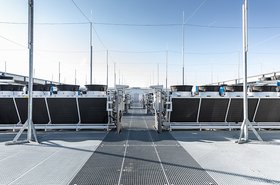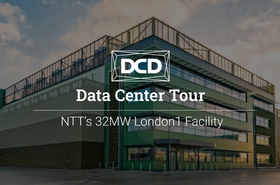As a large-scale data center with a PUE of 1.2, NTT’s London 1 is well worth looking into. The data center opened in December 2020 and decided to virtually open its doors and, to a certain extent, its heart. (In so much as a data center can have a heart.)
London 1 is unique, in that it has a huge capacity which is entirely self-powered. “One of the key things for this facility is that we have our own primary substation on-site. We have 132 kV of connection, providing 80 MVA of power to the site and coming from dual feeds. We then step it down ourselves onto the campus at 11 kV, and distribute it throughout the facility,” explains Amy Daniell, Director of Hyperscale Global Data Centers EMEA for NTT Ltd.
This enables the site to provide effectively for a range of customers, but it also brings fore the importance of running such a vast computing infrastructure in a way that is sustainable, both financially and environmentally.
“One thing that has been very clear to us over the past 18 months, is that data centers are being given the biggest platform of their entire lives in the public. Because of this, we're under a lot more scrutiny about our sustainability credentials. No longer do we fly under the radar, part of an infrastructure that nobody knows much about. Now, everybody is acutely aware that data centers back up everything that we do in our day-to-day life. You want to post a video on Facebook, you need the data center connectivity to be able to do that.”
“There is a responsibility from us as operators, as a whole industry, to be focusing on sustainability and how we are going to achieve those carbon-neutral goals, whether it's in two years, three years, or five years.”
“From NTT’s perspective, and specifically within this facility, we spent a lot of time on our design and deciding how we were going to be as sustainable as possible. Our cooling solution, for example, is giving us the ability to achieve a very good PUE.”
“We have a highly efficient water-cooled system, which is then topped up by a free cooling area. We also have hot aisle containment to try to minimize the amount of cross-contamination of cold and hot air.”
By putting sustainability at the heart of what NTT wanted to create, they have managed to achieve, for London 1, a PUE of 1.2, an achievement well worth recognition, as well as becoming the first large-scale data center to be awarded the BREEAM certificate.
Sustainability has obviously been very important to NTT, but it would be foolish to ignore other elements of the data center. It is, after all, a business first and foremost. This means not only providing for our planet in a positive way, but also ensuring that the customers are receiving state-of-the-art equipment and services, including a data center that is carrier-neutral, and more.
“We talk about carrier-neutral, but it is also important to be cloud-neutral in this day. We have a multi-service interconnection platform established in London, one facility to connect our customers to any of the major cloud service providers. I said to somebody a couple of years ago, that carrier neutrality is becoming less and less of a unique selling point because we are all like that. Whereas cloud neutrality and the ability to connect to different cloud platforms is something that we are very committed to at NTT.”
The ability for a data center to work with any cloud environment seamlessly is becoming increasingly imperative and is something that NTT is proving they value highly.
This desire to provide above and beyond expectations has resulted in a data center that does not offer the bare minimum.
NTT attempts not only to predict what their customers need today but to foresee what might be needed in the future. This planning is ingrained as deeply as the blueprint for the build and is in the very architecture of the building.
“We made sure that it was a slab construction so that we don’t have any raised floor. It is a concrete slab, which means that heavier, new generation racks can come into the facility that have a higher power density. If we have some of these very high-density customers, with up to 60 or 70 kilowatts per rack, we can accommodate a liquid cooling solution for those specific racks. The way that we built the facility means that we are very agile and able to respond to any customer requirements, which is critical for us to continue to be one of the market leaders.”
NTT opened their doors and their arms to help spread the word - we can learn more by sharing more. Perhaps, with more visibility, we can start to see other opportunities for the industry to grow, and work towards the carbon-neutral future we are all aiming for.
Watch the tour, panel, and roundtable here for more information about London 1.
Read more from NTT
-

Sponsored The Hyper-Connected Data Center
Putting reduced costs and better network performance at the center
-

NTT plans to grow its data centers by 20 percent in the next 18 months
Busy time for the Japanese service provider
-

Sponsored Four trends transforming the enterprise client-data center relationship
Well-established data center trends are accelerating as enterprise co-location customers become more sophisticated


